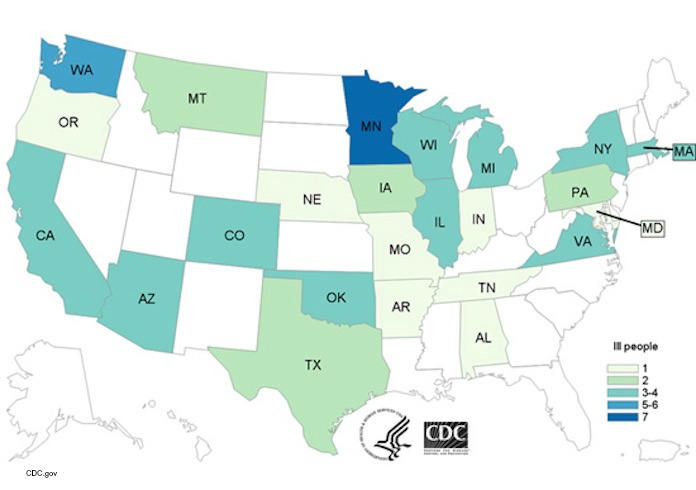The Centers for Disease Control and Prevention (CDC) has ended its investigation into the E. coli O26 and E. coli O121 outbreak linked to recalled Gold Medal flour from General Mills; however, our law firm continues to gather evidence that can be used in lawsuits for people sickened in this outbreak. Our E. coli lawyers can be contacted for a free lawsuit evaluation.
At least 63 people from 24 states have been sickened in this outbreak, an increase of 17 people from the last update in July 2016.

Our law firm has been investigating this outbreak and has been contacted by a number of people who were diagnosed with E. coli O121 and O26 infections.
The government’s investigation into the outbreak is over, but since the recalled flour and products made with it have long shelf lives, people are expected to get sick for “some time.” Many consumers do not know about the recalls or the outbreak. You can see a list of the recalled flour and products made with that flour, including bread mixes, brownie mixes, cake mixes, muffin mixes, pancake and biscuit mixes, and meat and poultry products at the CDC web site. If you have any of the products on the recall lists in your home, throw them away.
The case count by state is: Alabama (1), Arkansas (1), Arizona (3), California (3), Colorado (4), Iowa (2), Illinois (4), Indiana (1), Massachusetts (3), Maryland (1), Michigan (4), Minnesota (7), Missouri (1), Montana (2), Nebraska (1), New York (4), Oklahoma (3), Oregon (1), Pennsylvania (2), Tennessee (1), Texas (2), Virginia (3), Washington (5), and Wisconsin (4). Seventeen of those sickened were hospitalized. One person developed hemolytic uremic syndrome (HUS). No deaths were reported.
The patient age range is from 1 to 95, with a median age of 18. This low median age is attributed to the fact that teenagers like to eat raw cookie dough. The illness onset dates for this outbreak range from December 21, 2015 to September 5, 2016.
Evidence collected by public health officials indicate that flour produced at a General Mills facility in Kansas City, Missouri was the likely source of this outbreak. Many recalls, recall expansions, and secondary recalls were announced as the investigation proceeded.
Officials used the PulseNet system to find people who were part of this outbreak. Pulsed field-gel electrophoresis (PFGE) and whole genome sequencing (WGS) were used to identify bacteria collected from patient isolates and from product samples. Lab testing by the FDA isolated STEC O121 in open samples of General Mills flour collected from the homes of ill persons in Arizona, Colorado, and Oklahoma in June 2016. Then, in July 2016, testing by the FDA and General Mills found that a sample of General Mills flour was contaminated with STEC O26.
The government posted this statement: “This outbreak is a reminder that is it not safe to taste or eat raw dough or batter, whether made from recalled flour or any other flour. Flour or other ingredients used to make raw dough or batter can be contaminated with STEC and other germs that can make people sick.”
However, corporations are required by law to produce food products that are safe for consumers to eat. Even if someone never ate raw cookie dough, they could still get sick from these products because of cross-contamination from the flour or flour-containing product to any other food or food contact surface.
Lawsuit Against General Mills for E. coli from Gold Medal or Signature Kitchens Flour
You may have the right to sue General Mills for compensation if you have been sickened in this outbreak. Contact our law firm for a free consultation if you have been told you are part of the outbreak, or if you have been diagnosed with an E. coli O121 or O26 infection and are not sure if you are part of the outbreak.
These lawsuits seek damages for lost income, medical bills, and pain and suffering. Only an experienced food poisoning lawyer will be able to help with your particular situation.
The symptoms of an E. coli infection include a mild fever, severe abdominal cramps, and diarrhea that may be bloody or watery. Symptoms usually begin two to eight days after exposure to the bacteria. This infection can develop into hemolytic uremic syndrome (HUS), a serious complication that can lead to kidney damage and death. Symptoms of HUS include lethargy, easy bruising, skin rash, pallor, and little or no urine output. Other complications of an E. coli infection can include hypertension, seizures, stroke, paralysis, brain swelling, cortical blindness, heart failure, pancreatitis, and diabetes.